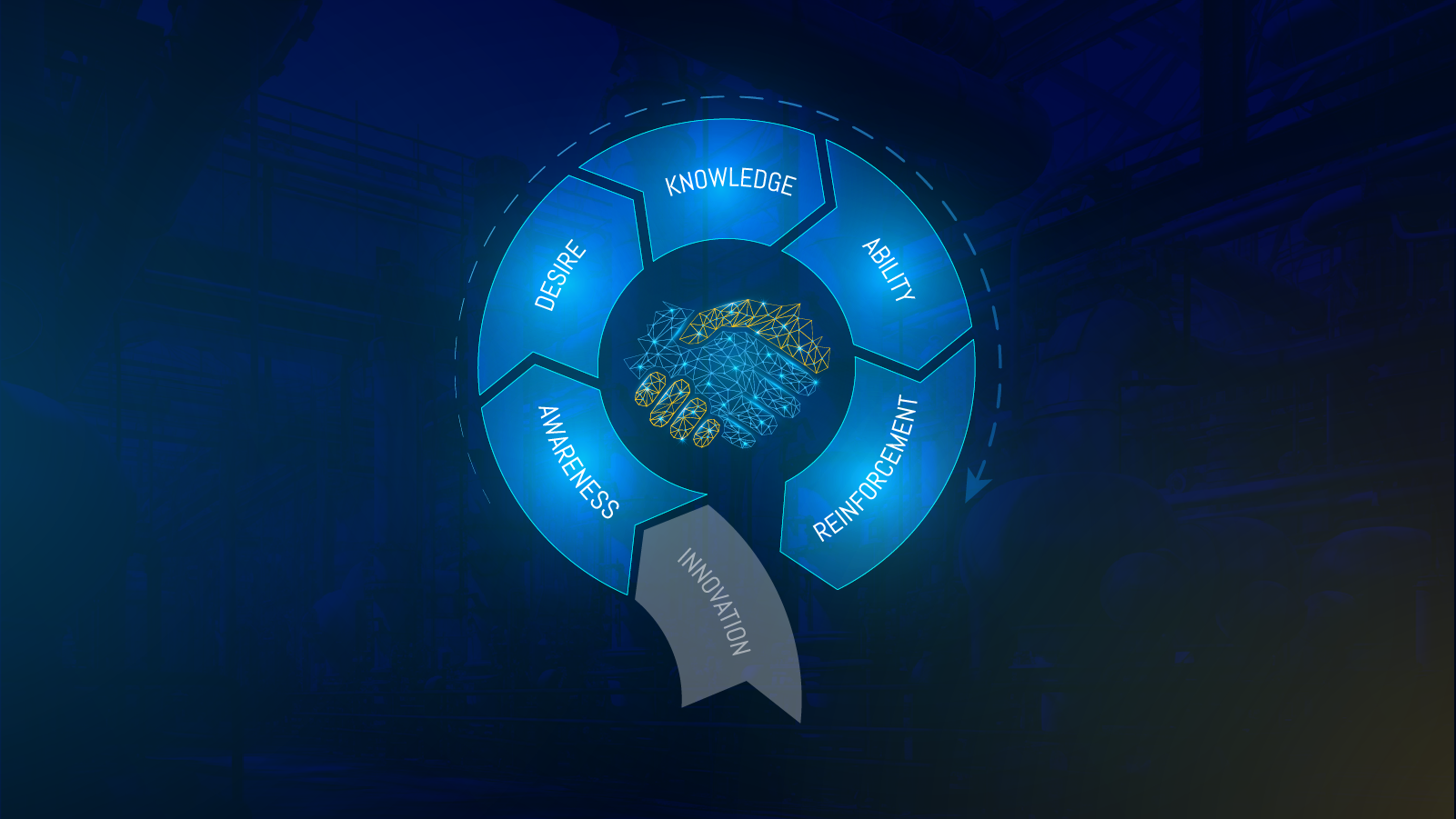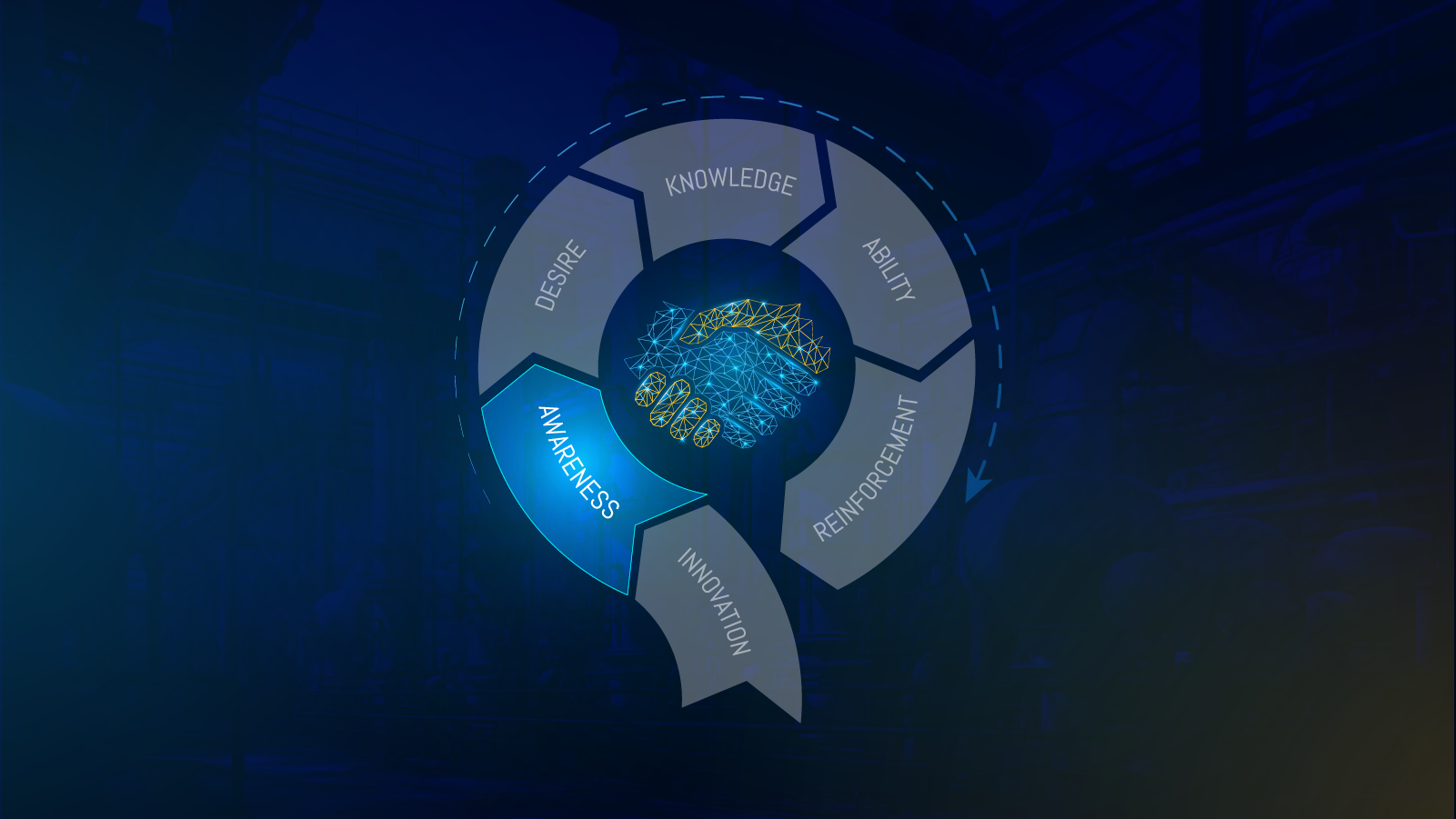Digital Completions in Plant Modifications and Upgrades
Unlike greenfield or any new build construction projects, plant modifications and upgrades present a unique set of challenges. Work is carried out...
5 min read
 Lisa De Vellis, PE
:
Oct 27, 2023 8:00:00 AM
Lisa De Vellis, PE
:
Oct 27, 2023 8:00:00 AM

Managing organizational change for successful digital transformation benefits hugely from a robust digital partnership. Leaning on a change management framework such as the 5-step ADKAR model lends clarity to advancing the human element, which is notoriously challenging.
Nudging users into accepting, embracing and championing new ways of working is essential to the uptake and scalability – and, hence, ROI – of the new software tools. The 5-step ADKAR model proposes doing this via:
The first two steps (Awareness, Desire) apply to the current status quo situation. The second two steps (Knowledge, Ability) apply to the transition phase. And, finally, the final step (Reinforcement) applies to the future scenario. That is the focus for this final piece in our series about managing DX in partnership.
In the ADKAR model, the fifth and final step is Reinforcement. At this stage, the users are aware of and want the change. They have been educated and properly upskilled to maximize the use of the new tools. Now, users are actively working with the new tools, of which they have become ambassadors change. When users take ownership of the change, they are most well placed to comment on the efficacy of their newly adopted tools. When user feedback is actively sought out, respected and responded to in meaningful ways, digital transformation takes on a life of its own.
And herein is the goal of the final ADKAR stage: Reinforcement creates a positive feedback loop where user input is valued and actioned, so users become ambassadors for the change, promoting a bottom-up approach for lasting, sustainable change.
In the ADKAR model of change management, Awareness and Desire seek to progress beyond the status quo. Change is needed to improve efficiency, safety and costs, but the change to current practices has not yet begun.
The transition stage – Knowledge and Ability – are the bridge that enable the implementation of new ways of working. Finally, Reinforcement focuses on the future and establishes a quest toward continuous improvement in digital partnership. To achieve the Reinforcement step, for lasting cultural change, the following actions are recommended to be pursued with your digital partner:
To track Reinforcement progress, implementing a reward system to incentivize continuous improvement is helpful:
Advancement in a DX journey would use ADKAR as a continuous loop: when the future scenario is achieved, create a new set of goals and revert back to the first Awareness step, using ADKAR as a positive feedback loop.
Improving the UI/UX of the software based on user feedback kicks off a positive feedback loop supportive of ADKAR in that it nurtures Awareness, Desire, Knowledge, Ability and Reinforcement of the users who are the ultimate gatekeepers of successful uptake.
Sustaining change is essential to maintaining momentum in a digital transformation journey. Reinforcement is what will sustain and advance that change through promoting user-informed development. This bottom-up approach will continuously support scalability of the technological adoption. Only then can maximum ROI be realized.
A real-world example of the importance of fulfilling the ADKAR stages to advance digital transformation comes from a paper titled “Digitally transforming EPC brownfield project execution with AWP: Applying the ADKAR change management model for scalability and improved uptake,” which was presented at the ADIPEC 2023 Exhibition and Conference.
This particular case study demonstrates the successful digital transformation in of an offshore brownfield UKCS asset thanks to a well-oiled digital partnership that created a positive feedback loop to encourages continuous improvement and user engagement. This resulted in successful uptake with potential for scalability to other assets so that the new digital tools will remain an integral part of the organization's culture.
Very early on in the introduction of the new software, upper management brought in middle management to the discussion. As a result, middle management quickly tackled the Awareness and Desire hurdles early in the digital transformation process, fostering a climate of trust at the onset rather than startling folks with unexpected change.
The change management process in this example was rooted in the trust cultivated early on – so people who might otherwise be reticent to change went into the transformation with an open mind. There was back-and-forth responsiveness, with upper management responding to and providing requested training under the guidance of their digital partner. Reliable, timely communication, encouragement, trust and responsiveness fostered a Desire for middle management to take a critical look at their current working practices.
This example progressed throughout the ADKAR model, reaching the final stage of Reinforcement. The digital partner alongside upper management asked users for feedback, which got brought back to the software developers. The digital partner then made little tweaks to the software based on what users said. Everyone was working toward the same goal – the customization changes to the software encouraged overall team integration.

From the start, the organization onboarding the software knew it wouldn’t be a quick fix, a cure-all to every problematic inefficiency in the previous methods. There are challenges in initiating changes to complex workflows, particularly when there are scheduling pressures. But because Desire existed, the organization were prepared, ready and willing to put in the effort to get over the hump toward an accelerated learning curve.
Since they really wanted the change, the organization invested in the whole package including a willingness to budget for onsite support from their digital partner. This, they rightly felt, was the best way to optimize ROI potential – the group was fully invested in and committed to the digital transformation.
The most critical element of this was incorporating DX expertise, including employing a specialist to look at one particularly complex system and help with integrating its digitalization into their existing systems. A full-throttled commitment is where digital partnership shines, and the partners in this example have already been looking at the next phases of what they can achieve together.
To maintain DX momentum in such an instance where the organization has successfully progressed well into the Reinforcement phase, the next steps would be to:
“Focus equally on adoption and development. User adoption starts with developing great technology solutions that offer an excellent customer experience. But companies often underestimate all the additional elements of the business model that need to be changed to secure adoption…That end-to-end system approach, with a focus on the people side of the equation, is what differentiates digital leaders. They achieve this by making the business accountable for the end-to-end transformation of the domain. As a rule, for every $1 spent on developing digital and AI solutions, plan to spend at least another $1 to ensure full user adoption and scaling across the enterprise.” (Lamarre et al., 2023)
ADKAR, and other change management frameworks, provide a roadmap to the successful uptake and scalability of new technological solutions. Using a change management model to facilitate the change, identifying and addressing human pitfalls, improves productivity, predictability and certainty of outcomes to create lasting cultural change in a DX process.

Unlike greenfield or any new build construction projects, plant modifications and upgrades present a unique set of challenges. Work is carried out...

Turnarounds and shutdowns are among the most critical—and stressful—phases in the management and operation of industrial assets. These planned...

Offshore decommissioning and asset retirement present significant logistical, regulatory, safety, fiscal and reputational challenges. The process of...

“Even the most advanced technology can’t achieve anything by itself. Value emerges as a combination of the tool and the people who operate it....

To realize increased efficiencies in construction execution, the ability to adapt to change by onboarding new technologies is paramount....
 Read More
Read More